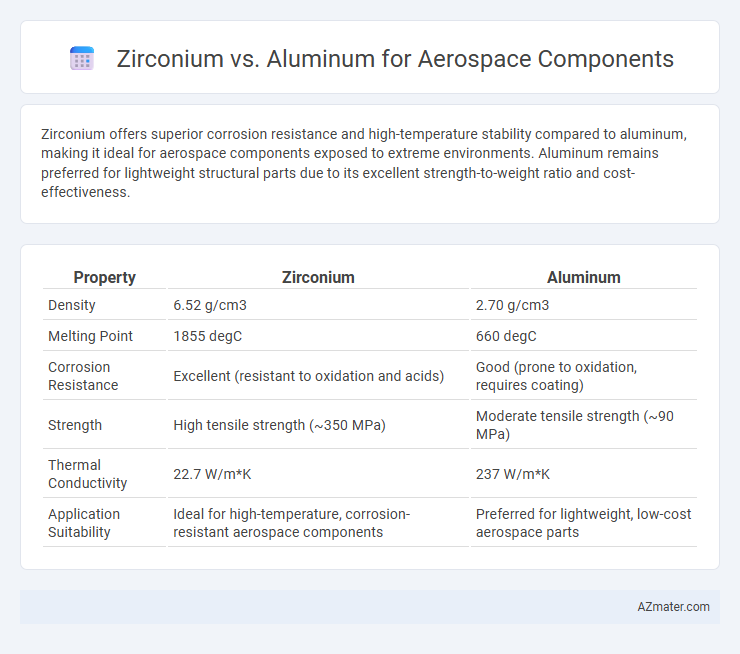Zirconium offers superior corrosion resistance and high-temperature stability compared to aluminum, making it ideal for aerospace components exposed to extreme environments. Aluminum remains preferred for lightweight structural parts due to its excellent strength-to-weight ratio and cost-effectiveness.
Table of Comparison
| Property | Zirconium | Aluminum |
|---|---|---|
| Density | 6.52 g/cm3 | 2.70 g/cm3 |
| Melting Point | 1855 degC | 660 degC |
| Corrosion Resistance | Excellent (resistant to oxidation and acids) | Good (prone to oxidation, requires coating) |
| Strength | High tensile strength (~350 MPa) | Moderate tensile strength (~90 MPa) |
| Thermal Conductivity | 22.7 W/m*K | 237 W/m*K |
| Application Suitability | Ideal for high-temperature, corrosion-resistant aerospace components | Preferred for lightweight, low-cost aerospace parts |
Introduction to Zirconium and Aluminum in Aerospace
Zirconium and aluminum are critical materials in aerospace engineering due to their unique properties. Zirconium offers exceptional corrosion resistance and high strength at elevated temperatures, making it ideal for components exposed to harsh environments such as jet engines and nuclear reactors. Aluminum, favored for its lightweight nature and excellent machinability, is extensively used in airframe structures and fuselage panels to enhance fuel efficiency and overall aircraft performance.
Material Properties Overview: Zirconium vs Aluminum
Zirconium offers exceptional corrosion resistance, high melting point (1855degC), and superior strength at elevated temperatures compared to aluminum, which melts at 660degC and has lower tensile strength. Aluminum provides advantages in lightweight characteristics, with a density of 2.7 g/cm3, whereas zirconium is denser at approximately 6.5 g/cm3, impacting overall component weight. The choice between zirconium and aluminum in aerospace components hinges on balancing thermal stability and strength against weight reduction and cost efficiency.
Weight Comparison: Zirconium and Aluminum Components
Zirconium exhibits a density of approximately 6.52 g/cm3, significantly higher than aluminum's density of about 2.70 g/cm3, resulting in zirconium aerospace components being considerably heavier. Aluminum's lower weight and high strength-to-weight ratio make it a preferred choice for weight-sensitive aerospace applications. Despite zirconium's superior corrosion resistance and thermal stability, aluminum remains dominant when minimizing weight is critical.
Corrosion Resistance in Aerospace Environments
Zirconium exhibits superior corrosion resistance compared to aluminum in aerospace environments due to its stable oxide layer that effectively protects against oxidation and chemical attack. This enhanced durability is critical for aerospace components exposed to harsh conditions like salt spray, high humidity, and temperature fluctuations. Zirconium's ability to maintain structural integrity under corrosive stress makes it a preferred choice over aluminum for critical aerospace applications requiring long-term reliability.
Thermal Conductivity and Heat Management
Zirconium exhibits lower thermal conductivity compared to aluminum, making aluminum more efficient for heat dissipation in aerospace components. However, zirconium's superior resistance to high-temperature oxidation enhances its heat management capabilities in extreme thermal environments. Aerospace applications prioritize aluminum for thermal conductivity but leverage zirconium for critical heat-resistant components where thermal stability outweighs conductivity.
Mechanical Strength and Durability Analysis
Zirconium exhibits superior mechanical strength and corrosion resistance compared to aluminum, making it ideal for aerospace components exposed to extreme environments. Its high melting point and excellent fatigue resistance ensure enhanced durability under cyclic loading and high-temperature conditions. Aluminum offers lightweight advantages but falls short in long-term strength retention and resistance to oxidation when compared to zirconium alloys.
Machinability and Fabrication Considerations
Zirconium offers superior corrosion resistance and high strength-to-weight ratio compared to aluminum, making it advantageous for aerospace components requiring durability in extreme environments. However, zirconium's machinability is more challenging due to its toughness and tendency to gall, necessitating specialized tooling and cooling techniques, whereas aluminum boasts excellent machinability with faster cutting speeds and less tool wear. Fabrication considerations for zirconium include strict control of contamination and oxidation during processing, contrasting with aluminum's more straightforward welding and forming capabilities in aerospace applications.
Cost Efficiency and Availability
Zirconium offers superior corrosion resistance and high-temperature strength compared to aluminum, making it suitable for specialized aerospace components, but its cost is significantly higher due to complex extraction and processing methods. Aluminum remains the preferred choice for most aerospace applications because of its abundant availability, lower cost, and excellent strength-to-weight ratio, enabling cost-efficient manufacturing at scale. The widespread accessibility of aluminum alloys and established supply chains ensure more predictable pricing and reduced lead times, enhancing overall cost efficiency in aerospace production.
Applications in Modern Aerospace Engineering
Zirconium is prized in aerospace engineering for its exceptional corrosion resistance and high strength-to-weight ratio, making it ideal for components exposed to extreme environments such as nuclear reactors and jet engines. Aluminum remains a staple due to its lightweight properties, excellent machinability, and cost-effectiveness, widely used in aircraft fuselage, wings, and structural frameworks. Modern aerospace applications increasingly integrate zirconium alloys in high-temperature turbine parts, while aluminum alloys dominate in airframe construction for optimized fuel efficiency and structural integrity.
Conclusion: Selecting the Optimal Material for Aerospace
Zirconium offers superior corrosion resistance and high temperature stability, making it ideal for aerospace components exposed to extreme environments. Aluminum provides a lightweight and cost-effective solution with excellent strength-to-weight ratio, suitable for structural parts requiring reduced mass. Selecting between zirconium and aluminum depends on balancing thermal resistance needs with weight constraints to optimize aerospace performance.

Infographic: Zirconium vs Aluminum for Aerospace component
 azmater.com
azmater.com